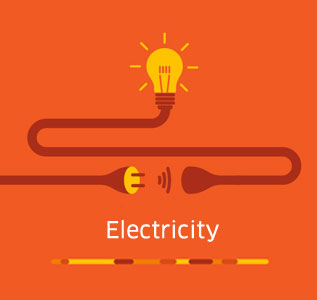Combined-Cycle Gas & Steam Turbine (CCGT) plant
The Combined-Cycle Gas & Steam Turbine (CCGT) plant generates energy using two different types of turbine in combination: a gas turbine and a steam turbine. The hot gases generated by burning natural gas power the gas turbine. The gases are still hot enough to generate steam in a heat recovery boiler which is then used in a steam turbine. The combination of these two thermodynamic cycles increases plant efficiency to between 55% and 57%, which is much higher than the 35% to 40% achieved by traditional plants.
This technique uses a single fuel to generate thermal energy (for heating and/or cooling) and electricity simultaneously. This system delivers a higher level of energy efficiency than can be achieved using separate heat and power generating facilities, and contributes to conserving energy resources. At domestic level, cogeneration boilers produce heat for space heating and domestic hot water heating, at the same time as electricity.
A burnable substance (wood, coal, gasoline, methanol, natural gas, etc.) used to generate heat.
HVAC (Heating, Ventilation and Air Conditioning)
HVAC stands for heating, ventilation and air conditioning; three distinct technical domains that contribute to occupant comfort by treating and distributing air in all types of building, from homes to offices and industrial plants. It also covers all the specialty skills and specialist technicians involved in heating, ventilation and air conditioning.
No energy conversion process can ever achieve 100% efficiency. The term ‘unavoidable energy’ refers to the quantity of energy inevitably present or trapped in certain processes, uncontrolled energy flows or materials. A proportion of this energy can be recovered and/or reclaimed. This term also applies to energy that would be lost if it were not used at the moment it is available, such as electricity generated from intermittent sources like wind power, solar power and run-of-river hydropower.
Energy directly available in nature (wood, coal, oil, wind, etc.) prior to any conversion processes and/or transportation.
Renewables are naturally occurring sources of energy that involve little or no waste or polluting emissions. These energy sources are either inexhaustible or can be rapidly regenerated by human intervention. Electrical power generated from renewables is referred to as ‘green power’.
Hydropower is a renewable energy source that harnesses the energy of moving water.
The joule is a derived unit of energy in the SI International system of units, and is used to measure energy (for work done) and the quantity of energy dissipated as heat. In the context of electrical power, one joule is the energy required to produce 1 watt of power for one second, or the energy transferred to an object when a force of 1 newton acts on that object in the direction of its motion through a distance of 1 meter. In terms of electricity and thermal energy, the most commonly used unit is the kilowatt hour (1 kWh = 3,600 kJ).
A fractional distillate of petroleum of quality between gasoline and diesel oil. At least 65% of its volume must be distilled at a temperature below 250°C. Its relative density is approximately 0.80 g/m3 and its flash point range begins at 38°C. Kerosene is used for heating and lighting, but may also be used as a fuel for some types of internal combustion engine.
The watt (W) is a derived unit of power in the SI International system of units, and is used to measure electrical power. One watt is defined as the power of one joule per second. The two most commonly used units refer to multiples of the watt: the kilowatt (kW), and for highly rated power generating plants the megawatt (MW).


